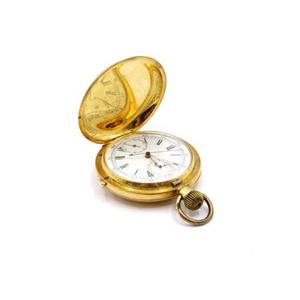Rare 18ct Gold Swiss Flyback Chronograph Fob Watch, Omega Movement
18ct gold Swiss Flyback chronograph fob watch case marked Helvtia 18k to the case and back plate. The Omega movement is marked Omega, case width 52 mm, weight 114 grams. Flyback stem wind mechanism and functions working when tested. Engraved: presented to Capt. F.J Bayldon R.N.R Residents of the New Hebrides (Vanuatu) in token of their esteem and goodwill 1st of May 1906. (Capt. F.J Bayldon was an Australian master mariner on the Canadian to Australia line 1897-1901. Royal naval reserve hydrographer and he was chief officer and master for the Pacific line. Bayldon had published works British Astronomical Association. A fellow of the Royal Australian historical Society and opened the Sydney nautical Academy. Appointed M.B.E. Bayldon Shoals Solomon Islands are named for him after he surveyed them). Engine turning decoration is rubbed, the monogram is clear
You must be a subscriber, and be logged in to view price and dealer details.
Subscribe Now to view actual auction price for this item
When you subscribe, you have the option of setting the currency in which to display prices to $Au, $US, $NZ or Stg.
This item has been sold, and the description, image and price are for reference purposes only.
- Movement - The technical name for the workings of a clock or watch, and does not include the dial or case.
- Back Plate - On many types of clocks, the movement operates between two plates, usually made of brass, one at the back, and the other at the front, which forms a mount for the dial.
On English bracket, mantle and table clocks the backplate was often visible through a glass door or panel from the late 17th century, and could be profusely engraved with scrolling decorations, flowers, foliage, birds, and figures. The engraving could also include the maker?s name.
The amount of engraving reduced and became simpler as the 18th century progressed, and by 1800, had been reduced to a border, often with the maker's name in the centre. By the early 1800s all decoration had ceased, and only the maker's name was added, and by the Victorian era, most bracket, mantle and table clocks had no engraving. - Chronograph - A chronograph is a watch that also incorporates the features of a stopwatch, to measure elapsed time. Most chronographs are operated by two buttons, one to start and stop the chronograph second hand, and the other to return that hand to the starting position.
This item has been included into following indexes:
